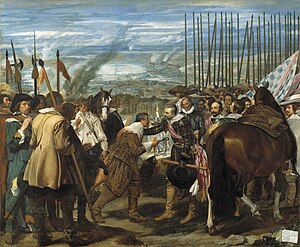Siege of Breda (1624)
| Siege of Breda | |||||||
|---|---|---|---|---|---|---|---|
| Part of the Eighty Years' War, Anglo-Spanish War and the Thirty Years' War | |||||||
 The Surrender of Breda by Diego Velázquez. Oil on canvas, 1635. |
|||||||
|
|||||||
| Belligerents | |||||||
|
|
|
||||||
| Commanders and leaders | |||||||
|
|
|
||||||
| Strength | |||||||
| 7000 (Dutch garrison) 7000 (English relief force) |
18,000 | ||||||
| Casualties and losses | |||||||
| 10,000 dead, wounded or captured | 3,000 dead, wounded or captured | ||||||
The Siege of Breda of 1624–25 occurred during the Eighty Years' War. The siege resulted in Breda, a Dutch fortified city, falling into the control of the Army of Flanders.
Following the orders of Ambrogio Spinola, Philip IV's army laid siege to Breda in August 1624. The siege was contrary to the wishes of Philip IV. The city was heavily fortified and defended by a garrison of 7,000 men. Spinola rapidly blocked its defences and prevented a Dutch relief army under the leadership of Maurice of Nassau from blocking access to his supplies. In February 1625, a second relief force, consisting of 7,000 English troops under the leadership of Horace Vere and Ernst von Mansfeld, was also driven off by Spinola. After a costly eleven-month siege, Justin of Nassau surrendered Breda in June 1625. Only 3,500 Dutchmen and fewer than 600 Englishmen had survived the siege.
The Siege of Breda is considered Spinola's greatest success and one of Spain's last major victories in the Eighty Years' War. The siege part of a plan to isolate the Republic from its hinterland. Although political infighting hindered Spinola's freedom of movement, Spain's efforts in the Netherlands continued thereafter. The siege of 1624 captured the attention of European princes and, for an interval, Spanish armies regained the formidable reputation they had held in the past centuries.
The capture in 1629 of a Spanish treasure fleet by Piet Heyn led to the capture of the fortress city of 's-Hertogenbosch, with the Stadtholder, Frederick Henry, Prince of Orange, breaking the land blockade. In 1637, after a four-month siege, Breda was recaptured by Frederick Henry. In 1648 the Treaty of Westphalia ceded it to the Dutch Republic.
...
Wikipedia
